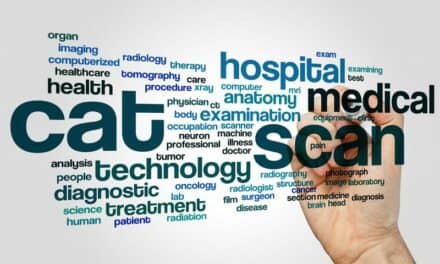64-Bit PACS Processing Boasts Faster Loading and Fewer Lockups
Running the Numbers
Product Showcase: Talking the Talk:Enterprise Dictation Solution Gets an Upgrade
Product Showcase: New Version of Image-Processing Software Released
Product Showcase: DICOM Image-Importing Solution Transfers Files Regardless of Source
Product Showcase: Web-Based Voice-Capture and Transport Solution Now Available
64-Bit PACS Processing Boasts Faster Loading and Fewer Lockups
By Cat Vasko
Merge Healthcare (Milwaukee) recently announced the impending release of its new 64-bit processing environment for PACS, which allows more than 10,000 images to be loaded simultaneously without eroding system performance. Medical Imaging spoke with Tim Kulbago, vice president of product innovation and chief technology officer at Merge, about the new capability.

|
| Tim Kulbago |
MI: Can you give an overview of what 64-bit PACS processing means and why it is such a big advancement?
Kulbago: You have to look backward a little bit at the old 32-bit systems. Those systems have a limitation on the amount of physical memory and virtual memory that you can access in the computer. Ultimately, there’s only so many images and information you can open before the computer [stops working properly]. Typically, vendors have to invest a lot of time and money on making their systems work intelligently in the 32-bit world; and the technical guys play tricks to work around the 32-bit limitation. Because the 64-bit has a much larger memory model, we can literally open tens of thousands of medical images at once. The clinical benefit of that is pretty intense. Now that multi-slice CT has been out in the market for a while, people are starting to have priors with lots of studies. We’re now able to deliver all of those priors, all of those images, to the radiologist without degradation in performance.
MI: Is 32-bit the current standard for PACS?
Kulbago: Yes, it’s 32-bit or 32-bit plus proprietary memory management, where somehow you figure out how to work around it. But from our perspective, the future is 64-bit. Everything runs faster, and everything gets more memory space. One thing that is very important to point out is that our [PACS software] is a true native 64-bit application. You can run software on a 64-bit operating system, but all it means is that there’s a mode called 32-bit emulations, which looks to your software like it’s a smaller machine. So, maybe you can run two applications at once on a 64-bit operating system, but it’s different from having a truly native 64-bit solution.
MI: How did you update your PACS to make 64-bit processing possible?
Kulbago: A couple of ways. Our PACS solution is built on the Microsoft .NET platform, and .NET already supported 64-bit, so we didn’t rewrite the PACS. That’s really important from my perspective, and for our customers. They’re asking, “Is this new? Have you worked out all the bugs?” And we’re answering, “It’s our Fusion Matrix PACS that we’ve been selling for years.” So the good news is, we didn’t do a whole lot with the software. Then, you have to put it on the appropriate hardware and operating system. The new chips from Intel, the new boxes from Dell, the Windows 64-bit operating system—all of that needs to be in place for this to work. And the good news is that we have the ability to sell those items and offer them with this release. In addition, for a little while, we’ve been shipping our 32-bit solutions on 64-bit hardware.
MI: So, this is a shift that Merge has been anticipating for a while?
Kulbago: Yes. Now, if you bought a machine 3 years ago, sorry—the technology didn’t exist then. But some of our customers actually are on the appropriate hardware, and all we have to do is upgrade their operating system and our software, and they’re running in 64-bit.
MI: Is this something that’s going to scale? Will you come to 128 and eventually 256?
Kulbago: I’m sure that will happen someday. But for right now, the virtual memory limitation on 64-bit computers is measured in terabytes. It’ll be a while before we see a 128-bit version.
MI: How does this impact storage?
Kulbago: It’s not a really big impact. The storage solutions we have are dealing with terabytes of data already, and since we don’t have to put them all in the memory at once, 64-bit is really not as important on the back-end storage side. We are actually running our 64-bit PACS client side with 32-bit-enabled applications on the back end. You put the technology where the value is.
MI: And how does 64-bit PACS impact computing power?
Kulbago: Obviously, the 64-bit processors on the client side are the most sophisticated processors in the Intel/PC market right now. So by definition, they’re faster, and they do more complex instructions per second. But the real benefit is the memory model. It runs a little faster, but where it gets interesting is the move into multi-core processors, which are 64-bit enabled and allow us to do more things at once.
MI: What are your release expectations?
Kulbago: We are actually in some form of alpha or beta testing right now, depending on how you define it, and we are expecting a release in early November.
MI: Just in time for RSNA, right?
Kulbago: Well, the good news is that we’ll have a little release time under our belt by the time RSNA rolls around. We’re not going to be doing vaporware for this year’s RSNA; the 64-bit is going to be there and be very tangible.
Cat Vasko is associate editor of Medical Imaging.
Running the Numbers

|
38.9% of respondents? facilities have been using PACS for 5 years or more. In our August monthly Web Poll, we asked readers how many years their facilities have been using PACS; these are the full results.
To participate in Medical Imaging?s latest Monthly Web poll, visit the poll location on the left side of the home page.
Product Showcase: Talking the Talk: Enterprise Dictation Solution Gets an Upgrade
New from Nuance Communications Inc (Burlington, Mass) is the latest version of the Dictaphone Enterprise Suite, a dictation and speech-based transcription-processing solution. The Suite incorporates the Enterprise Express VoiceSystem, Enterprise Express TextSystem, EXSpeech, and Enterprise Workstation.

|
| The newest version of the Dictaphone Enterprise Suite from Nuance increases automation, improves report quality, and features better connectivity. |
Nuance acquired Dictaphone Healthcare Solutions earlier this year; the new version of the Enterprise Suite is the first Dictaphone release since the acquisition. “Dictaphone has long been a leader in speech recognition and documentation for health care, and with continued investment by Nuance, that leadership will continue,” Robert Schwager, president of the Dictaphone Healthcare Solutions division at Nuance, said in a press release.
The new version of the Enterprise Suite has increased automation rates, improved report quality, and simplified how organizations manage their workflow process. The Suite includes:
- EXSpeech 5.0—automatically sorts which recordings should be sent to trained editors and which should flow directly to manual editing;
- Enterprise Workstation 3.0—expands interoperability with single-login capabilities and data connectivity to PACS, EMR, and home-grown portal systems; and
- Enterprise Express VoiceSystem 7.0 and TextSystem 7.0—for improved workflow via the automatic concurrent review feature.
Nuance also touts the system’s physician-friendly aspects, noting that it often delivers a technology payback in a year or less. For more information, visit www.nuance.com/dictaphone/hospitals.
Product Showcase: New Version of Image-Processing Software Released
Media Cybernetics Inc (Silver Spring, Md) recently announced the release of version 6 of its Image-Pro Express software, which features new image-processing, measurement, and analysis tools.

|
| Image-Pro Express v6 features new image-processing, measurement, and analysis tools. |
Included among v6’s image-processing tools are edge filters for improved object identification, forward and inverse fast fourier transforms to better eliminate artifacts, and a color composite feature to compile color images from multiple grayscale images. New measurement tools, like those included for metrology, thickness measurement, and edge detection, facilitate the collection of advanced measurement data. Other new features with v6 include Surface Plot, which enables the display of image-intensity values in a 3D plot, and Data Collector, which stores information from the analysis of multiple images.
Image-Pro Express is a lighter edition of the company’s Image-Pro Plus system; it is designed for those who need basic manual measurement and analysis tools. A demonstration version of Image-Pro Express v6 is available for download at www.mediacy.com.
Product Showcase: DICOM Image-Importing Solution Transfers Files Regardless of Source

|
| The PowerPACS Image Importer is DICOM compatible and conforms to IHE profiles. |
The PowerPACS Image Importer from RADinfo Systems Inc (Dulles, Va), was unveiled at the 2006 Veterans Affairs E-Health University Meeting in Nashville, Tenn, August 21?23. PowerPACS is the newest image-importing solution from the RIS/PACS solutions provider.
PowerPACS can import images from such sources as patient CDs, DVDs, legacy PACS, or Structure Report; it is fully compliant with the IHE Portable Data for Imaging and Import Reconciliation Workflow profiles. The solution also features intelligent matching algorithms to automatically link incoming images to proper existing records or to prompt the operator to verify the match; it can edit image attributes, after which it stores modified attributes in the original image should they need to be traced.
For more information, visit www.radinfosystems.com.
Product Showcase: Web-Based Voice-Capture and Transport Solution Now Available
A new dictation solution from MedQuist Inc (Mount Laurel, NJ) offers HIPAA-compliant, Web-based digital voice capture and transport. The DocQment Ovation system offers tools to manage documents, users, and workflow from any computer with Internet access. Physicians also can choose from a variety of options for capturing their dictation—including telephones, PDAs, and computer-based dictation devices.
“Ovation helps to provide an end-to-end solution from dictation to billing, including front-end and back-end speech recognition,” Scott Bennett, senior vice president of sales and marketing at MedQuist, said in a press release.

|
| The Dashboard feature on MedQuist?s DocQment Ovation, a Web-based dictation and transcription system, provides transcription supervisors with a department and document overview. |
Once Ovation is installed, users simply visit a predetermined URL to reach the server and download the thin client at their PC workstation, without any additional technical assistance required. DocQment Ovation is compatible with MedQuist’s previous-generation dictation stations; minimal physician retraining is required to upgrade. Ovation can be integrated into any PACS solution by using EX stations in serial format.
The system also provides an enterprise view, allowing transcription supervisors to easily manage users, documents, and voice files from a single dashboard. “Capabilities engineered into DocQment Ovation—like the ability to define the date that begins the aging process for documents, including admit date and date of discharge—give users better information at the point of dictation to improve workflow, accuracy, and report routing,” said Emily Weber, vice president of product management at MedQuist.
According to Wanda Newton, health information management director at Maury Regional Healthcare System (Columbia, Tenn), “With MedQuist’s help, we configured DocQment Ovation around the way we do business. We now are managing our hospitals and departments more efficiently. We saw a 34% increase in productivity in the first 2 months of using Ovation, a positive trend that we expect will continue.”
For more information, visit www.medquist.com.





